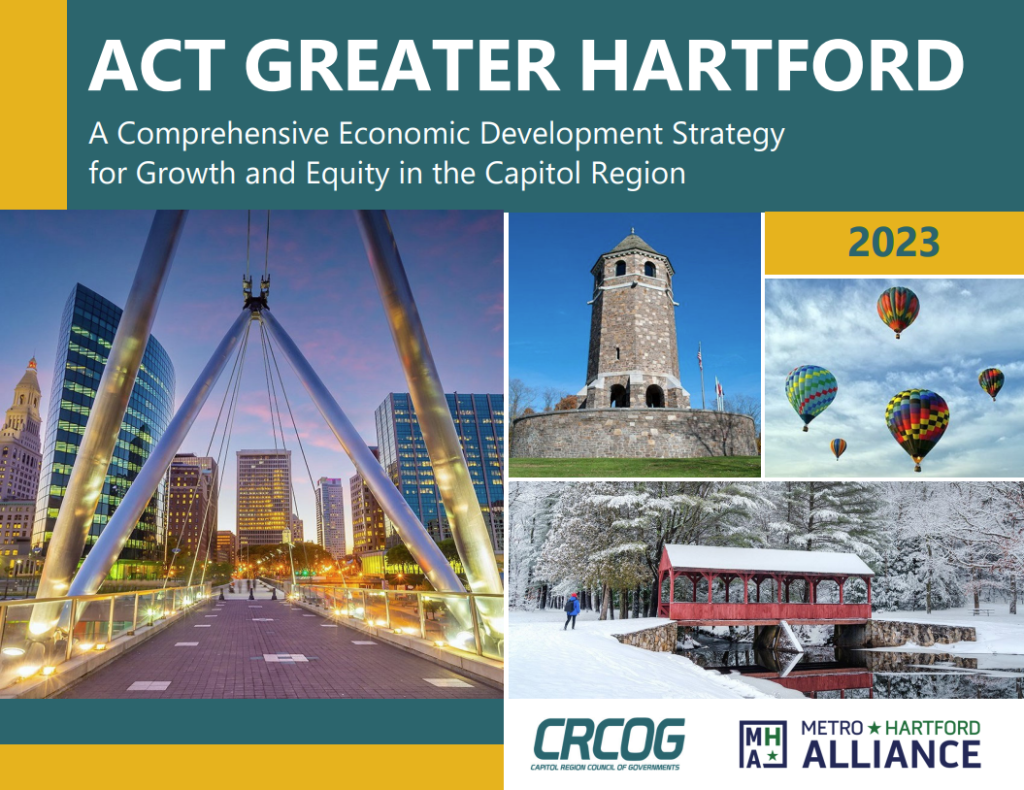Overview
The Capitol Region Council of Governments is dedicated to maintaining and enhancing the regional economy which allows the residents and businesses that call our region home to be supported and thrive. To do this CRCOG develops and updates a number of plans which can be found on this page. Through these plans accompanied by strategic programming and initiatives staff pursue 3 economic goals:
a) educate, train, and retain talent - with a focus on underserved and underrepresented populations - to better meet the needs of the region’s employers and to create jobs paying a family living wage;
b) enhance the quality of place amenities throughout our region to retain and attract talent; and
c) strengthen collaboration to support and promote the region’s industry strengths.
Regional Comprehensive Economic Development Strategy (CEDS)
Every five years, a Comprehensive Economic Development Strategy, or CEDS, is required to be prepared and updated. When CRCOG’s last CEDS plan was published in 2019, projections anticipated a period of growth, with a strong insurance and financial sector, resurgent advanced manufacturing, emerging biotech and other strengths. The COVID-19 pandemic upended the global economy in unexpected ways, forcing both governments and businesses to shift their focus to reconfigure ways for businesses operate and recruit workers, households to adjust to sudden job losses (and gains) and adapt to a new normal.
In June 2022, CRCOG began working with Camoin Associates and various partner organizations to update the CEDS for 2024-2029. We recognized recovery from the economic disaster of a pandemic required more than strategies and a plan, but also specific actions and committed partners to implement the strategies identified. ACT Greater Hartford – A Comprehensive Economic Development Strategy for Growth and Equity in the Capitol Region is the result.
Brownfields
Brownfields are underutilized properties which are difficult to redevelop due to the presence or potential presence of hazardous substances, pollutants or contaminants. As a former manufacturing hub, the Greater Hartford region contains many such sites, including historic factories, agricultural land, former dry cleaners, former gas stations, and other stagnant properties. While there are more than half a million identified Brownfield sites in the U.S., the numbers are likely much higher.
Municipal and Small Business Resource Center
Small businesses are a vital part of our economy. A 2019 Small Business Association (SBA) Report found that small businesses accounted for 44% of U.S. economic activity. Check our Municipal and Small Business Resource Center Page!
To increase economic recovery after the COVID-19 pandemic, CRCOG launched this clearinghouse to connect municipalities, small businesses, and entrepreneurs to the resources needed to assess existing community resources, identify and mitigate vulnerabilities, and to better understand the populations and workforce in our Region's business corridors. This Municipal and Small Business Resource Center was developed using funds from the U.S. Economic Development Administration CARES Act, through the CT Department of Economic and Community Development.
Third Places Topical Report
Third Places are your favorite spots to hang out. They are places filled with lively conversations and laughter. Third places are welcoming to everyone and feel comfortable to stop in and stay for a while. Some good examples are parks, cafés, pubs and piazzas, where people can meet informally.
Strong, resilient communities make it easy to gather and connect with other people. As we continue to recover from the pandemic and grapple with a growing mental health crisis, the importance of third places as the civic and social glue of communities has never been more important. Local land use and economic development commissions have the opportunity to tangibly improve not only the economic, but social health of their communities through the creation of vital third places.
This report will help municipal decision-makers at the elected, commission, and staff level better understand what third places are, their importance, and examine how to encourage their development. We highlight great third places in the CRCOG region and outline tools and strategies for communities to help build a more diverse, robust network of third places.
Related & Previous Plans
Enter description text here. Lorem ipsum dolor sit amet, consectetur adipiscing. Quo incidunt ullamco.


